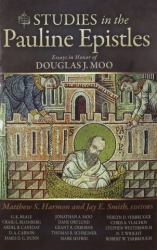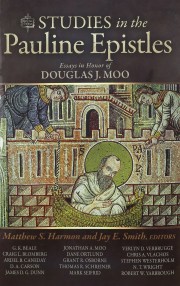The name Douglas J. Moo is familiar to students of the New Testament all over the English speaking world. For the several decades of his career his work has been marked by careful exegesis and insightful analysis coupled with a devout reverence for God’s Word. He is a good friend of Books At a Glance, a faithful Christian, and we were excited to see the release of this festschrift in his honor. Studies in the Pauline Epistles is a fitting tribute to his outstanding contribution to biblical scholarship, and editors Matthew Harmon and Jay Smith are with us today to talk about their work.
Books At a Glance (Fred Zaspel):
First, by way of background, tell us about your own relationships with Doug Moo and how this book came about. How long was it in the works?
Harmon & Smith:
 We both had the privilege of doing our doctoral work under Doug’s supervision. Jay studied under Doug at TEDS and likes to say that he maintained a relationship with Jenny and him over the years in spite of that fact. I (Matt) took a couple of classes from Doug while working on my M.Div at TEDS before he left for Wheaton to head up their new Ph.D. program. When I finished my studies at TEDS I followed him to Wheaton to do my doctoral work under his supervision. During those three years he became more than my doctoral mentor; he became a friend.
We both had the privilege of doing our doctoral work under Doug’s supervision. Jay studied under Doug at TEDS and likes to say that he maintained a relationship with Jenny and him over the years in spite of that fact. I (Matt) took a couple of classes from Doug while working on my M.Div at TEDS before he left for Wheaton to head up their new Ph.D. program. When I finished my studies at TEDS I followed him to Wheaton to do my doctoral work under his supervision. During those three years he became more than my doctoral mentor; he became a friend.
This Festschrift to honor him was in the works for about four years. Before this project Jay and I didn’t know each other. We each had the idea separately and providentially mentioned it to our mutual friend, Ardel Caneday. He connected the two of us and we went from there. The fact that we were able to keep this a secret from Doug for that long was a special kindness of God! Doug’s wife Jenny and daughter Christy were instrumental in helping us keep Doug in the dark. We presented it to him as a surprise at an ETS meeting in San Diego this past November, with most all of his family present.
Books At a Glance:
Explain the structure you’ve given to the book, dividing the 16 chapters into three major sections. How were these chosen, and how are they significant for this project?
Harmon & Smith:
Because we wanted our contributors to have significant freedom to pursue what was most important, interesting, or relevant in light of our honoree, we allowed them to write on any area of interest within the field of Pauline studies. So once we had a clear sense of what each author was writing on, we organized the essays into three broad categories. The first is Exegeting Paul, which has six essays that explore specific Pauline texts and draw out their implications for Pauline theology, historical background, or translation. The second section is entitled Paul’s Use of Scripture and the Jesus Tradition. These three essays tackle the challenging topic of Paul’s engagement with the Old Testament, as well as his interaction with the earliest traditions about Jesus’s life, ministry, and teaching. The final, and longest, section is Pauline Scholarship and the His Contemporary Significance. These seven essays fly at a slightly higher altitude to address key questions in field of Pauline studies today, including salvation history, eschatology, the New Perspective(s) on Paul, and apocalypticism.
So despite not starting out with these three broad sections, we were very pleased to see the contributions fall into these categories. The result is a book that we believe gives a helpful cross section of the field of Pauline studies today as well as reflects different areas where Doug has made significant contributions to both the academy and the church.
As for choosing the contributors, this was one of the hardest parts of the project. We began with a very lengthy list, but eventually narrowed it down by thinking through several (often overlapping) categories such as friends (Verlyn Verbrugge, Tom Schreiner), one of his sons (Jonathan Moo), former colleagues from TEDS (D. A. Carson, Grant Osborne, Robert Yarbrough), Wheaton (G. K. Beale), the NIV Translation Committee (Craig Blomberg), former students (Ardel Caneday, Chris Vlachos, Jay Smith, Matt Harmon, Dane Ortlund), and prominent Pauline scholars (James Dunn, Stephen Westerholm, N.T. Wright, Mark Seifrid). The respect and admiration for Doug were readily evident as the contributors expressed their eagerness to participate.
Books At a Glance:
The so-called “New Perspectives” (NPP) on Paul loomed large in Pauline studies over the last generation. How would you characterize Moo’s contribution in this area of study?
Harmon & Smith:
Doug takes what he himself describes as a “mildly critical” stance towards the New Perspectives on Paul (Encountering the Book of Romans, 11–12). His primary engagement with the NPP has come through his commentaries on Romans and Galatians, where he patiently addresses those views in the context of trying to explain what the text means. Doug is quick to acknowledge where the NPP has made helpful contributions to understanding the text, yet straightforward in his disagreement when he believes those views are contrary to what the text says and means. By engaging the issues surrounding the NPP at the exegetical level Doug has not only modeled the priority of the text but demonstrated to us the implications of the NPP for our understanding of Paul and even the Christian life. Of course, Doug has also engaged the NPP in more focused articles/essays as well, dealing with specific issues related to Paul’s view of the Law and critical engagement with various NPP advocates. But his most enduring contributions to this discussion will likely prove to be his interaction at the “ground level” of exegetical detail and textual meaning. (A bibliography of Doug’s works can be found in the back of Studies in the Pauline Epistles, 287-93).
Books At a Glance:
You arranged some surprising chapters in this regard – please tell our readers about them and how they came about.
Harmon & Smith:
James Dunn is one of the most well-known advocates of the New Perspective(s) on Paul. By contrast Stephen Westerholm is a prolific proponent of the so-called “traditional/Lutheran/Old Perspective.” We thought it would be interesting to have each of them write an essay affirming what is right about the view they do not personally hold. So the result is Dunn writing an essay entitled, “What’s Right about the Old Perspective on Paul?” and Westerholm writing one entitled, “What’s Right about the New Perspective?” Of course neither of them has changed their views! But we believe readers will benefit from this friendly exchange and perhaps gain further insight into the ways that both the Old and New Perspectives can contribute to our understanding of Paul.
Furthermore, we believe these two essays are not only a helpful contribution to ongoing discussions about the NPP, but a fitting tribute to Doug. One of the distinctive elements of Doug’s writing is his ability to summarize accurately and clearly views he does not hold, as well as affirm the strengths of those views. Both the academy and the church need more examples of affirming elements of viewpoints one does not hold as a means of furthering dialogue.
Books At a Glance:
Doug Moo has played an important role in New Testament studies for our generation. How would you characterize his contribution overall?
Harmon & Smith:
In Studies in the Pauline Epistles, Dane Ortlund has done a great job of capturing Doug’s various contributions. But we can try to whet the reader’s appetite by noting a few areas here.
Doug has contributed to both the academy and the church on several levels. His commentary writing has shaped the way that both scholars and pastors have understood and taught Romans, Galatians, Colossians, Philemon, James, 2 Peter, and Jude. Lord willing, in the years to come, Doug is scheduled to write on Hebrews and Philippians as well. Countless believers have returned time and time again to Doug’s commentaries and found a reliable resource marked by penetrating exegetical and theological insight and thoughtful suggestions for application written with his characteristic clarity, depth, and good sense. Indeed, Doug himself has identified this aspect of his ministry as central to what God has called him to do (see here). His Introduction to the New Testament has also been widely used in seminaries and colleges around the world to orient students to the landscape of the New Testament. Beyond his commentary writing, Doug has made significant contributions in the areas of the New Testament use of the Old Testament, creation care, theology, and ethics as well.
Through his many years of teaching at TEDS and Wheaton Doug has helped train a generation of men and women serving in a variety of ministries worldwide. He regularly travels and lectures in venues here in the United States and around the world. Only the Lord truly knows the impact Doug has had on these students as they faithfully preach and teach God’s Word.
One final area where Doug’s contribution to the advancement of God’s kingdom may not be as widely recognized is through his involvement with the Committee on Bible Translation, the group responsible for overseeing the New International Version. As a member since 1997 and chair since 2006, Doug has helped to shape how countless millions have read God’s Word.
Editor’s Note:
Here is a video of the festschrift presentation to Doug Moo.
A video interview with Matthew Harmon about the book.
And a video interview with the Jay Smith.
Buy the books

Studies In The Pauline Epistles: Essays In Honor Of Douglas J. Moo
